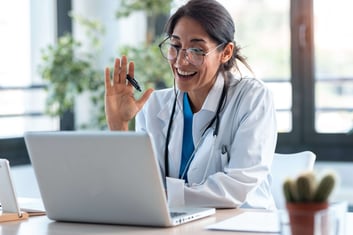
Informatics and data are more intertwined with science and healthcare than ever before. Over the past several years, we’ve seen rapid growth of IoT and connected devices in life sciences with goals to enhance value-based care, population health, and the public’s well-being. The shift toward consumer technology has led many device and product-based companies like Sleep Number and ResMed to morph into health-tech companies overnight.
Behind the scenes of these technological advancements lies the hard work of Biotech scientists such as Biostatisticians and Bioinformaticians, who currently have the largest hand in developing innovative healthcare technology. Health-tech companies are working alongside these scientists to interpret the data they collect and enhance product capabilities to promote healthier living.
Here’s how scientists, companies, and healthcare are fostering a healthier future for us all.
3 TRENDS INSPIRING HEALTH-TECH & BIOTECH TO WORK TOGETHER
1. The radical shift towards digital is here to stay
The fact that digital is here to stay is especially true in healthcare. More than ever, connected devices are providing instant, accurate biostatistics surrounding public health. But, with more focus on digital comes more data collection and analysis.
Companies like Sleep Number have placed heavier emphasis on digital health through data gathered from their products. Sleep Number beds can now measure biometrics such as heart rate, sleep habits, breathing patterns, and movement. The data collected goes straight to the cloud, where AI monitors it through a quatrain of algorithms. Then, the information is imparted to medical providers where doctors can provide proactive care.
This process is not without Biostatisticians, Bioinformaticians, Clinical Data Management, and Integration Architects to name a few, whose roles are responsible for developing health tech tools from the analysis of data they collect.
2. Software, therapeutics and vaccines - in that order – are helping solve public health issues such as Covid-19
The combination of technology, science, and medicine are working hand-in-hand to solve public health issues. At Yoh, we saw this unfold amid the COVID-19 pandemic. Our Life Sciences and Validation customers, using Yoh scientists and engineers, began working to identify the virus that would eventually be known as COVID-19, and to develop possible therapies and vaccines to combat it.
Unknowns surrounding COVID-19 are still vast, and the demand for alternative therapies to care for an aging population continues. Our expert teams of STEM professionals across the areas of R&D, data analytics, validation, compliance and quality, constantly showcase how software and labware meet and become the ticket to solving current and future public health issues. Our professionals in data analytics, integration, and benchtop science relentlessly pursue new advances in target therapeutics, while helping Yoh's customers keep up with the demand for common medications and therapies for other diseases.
3. Consumers have changed their habits regarding well-being and health
Consumer behaviors have changed, and it all boils down to trust! Today’s consumers trust their connected devices to collect and send timely, accurate measurements of their health to their healthcare providers. This is a radical shift in the consumer mindset. As people begin to understand the health benefits of connected devices and wearables, companies are jumping on board to supply the technology.
If you own an Apple Watch, you’ve witnessed this first-hand: You can connect your device to a universe of platforms and apps that will monitor simple biometry like your heart rate. Paired with your demographics and personal health information, any irregular pattern in your readings might indicate you’re experiencing hypertension or another serious health concern. From there, your device can suggest a medical treatment plan like “visit your PCP to review condition and prescribe a maintenance medication AMLODIPINE.”
Another notable shift is the adoption of virtual healthcare. There exists a sizeable demand for telehealth since the onset of the COVID-19 pandemic. Convenient at-home care and savvy data collection methods made it easier for individuals to select telehealth over traditional healthcare options. With the digital world continuing to expand across industries and the changing landscape of global health, the future of healthcare is telehealth and the Biotech roles that support it!
THE IMPACT OF CONNECTED DEVICES
The world is looking towards technology, data, and science for answers to very complex health-related issues. Luckily, advancements are being made, and the talent exists between software to labware, for continuous innovation. It will take the combined efforts of health-tech companies, Biotech scientists, and healthcare providers working together to foster a more health-conscious world. With IoT and connected devices proving immense value, this goal is becoming a lot more possible and these scientific roles will continue to be a mainstay for years to come, and hiring in Life Sciences continues to flourish.


